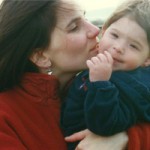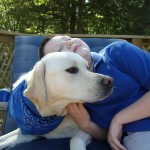On February 29, 2012, Rare Disease Day, I hosted a conversation with Catherine Fairchild Calhoun and Laurie Strongin, two people who have inspired me in my research about the social impact of the internet on health.
They have also inspired me personally, finding joy and reasons to laugh when I think I’d just sit down and cry. They are mama birds, showing us all how to fly high, sing our songs, and nourish our children with love — you’ll see what I mean.
Catherine, who was visiting from Louisiana, has a son named Billy who has McCune-Albright Syndrome, a one-in-a-million genetic disorder. She is on the board of Marble Road, which connects people who have complex illnesses with specialty health care services. Laurie is the author of the book, Saving Henry, and runs a non-profit named Hope for Henry, both of which are named for her son who died in 2002 of Fanconi anemia, another rare genetic condition.
You’ll first hear the voice of Catherine, describing how she couldn’t shake a feeling that something was wrong with Billy, her second child. Although she had no medical training, she did enough research online about her suspicions to go “toe to toe” with a pediatric neurologist who at first wouldn’t believe her.
Catherine uses a few technical terms, including choroid plexus cysts, or CPCs, which can be an indication that a baby in utero has Down’s syndrome and other conditions.
You’ll also hear Laurie chiming in with her agreement that there is a celebrity to rare disease, when clinicians discover that your child has something they thought they’d never see outside a textbook.
Track/segment 1: Online research and intuition saves Billy’s life
 |
The second segment starts with my favorite story about Catherine. She has referred so many patients to Billy’s endocrinologist that the doctor calls these appointments “consults for Dr. Calhoun.” As Catherine points out, moms find each other and make recommendations for where to get the best care. She and Laurie talk about how important it is to find clinicians who are energized by an engaged parent, who will prepare for your appointments knowing that you’ll also come prepared. And yet they want the doctor’s expertise and experience because “we can’t know everything.”
Track/segment 2: Consults for Dr. Calhoun
 |
In the third segment, Laurie talks about how, when Henry was born in 1995, there was no Google, no way to network online with other parents. And yet parents managed to find each other and share what information they could, educating themselves and each other to join in the fight against a common enemy.
I refer to the section of Laurie’s book in which they found out that Henry, age 5, who had endured a bone marrow transplant, had a mass of unknown origin in his brain. Here’s an excerpt from Saving Henry:
I was stunned. Nothing I had ever read, and I had read a lot, ever noted that brain tumors were part of the transplant recovery. I was tempted to run and grab the kids and leave that awful place…
In the first months of Henry’s life, we were able to learn everything about tetralogy of Fallot, the heart problem Henry was born with, and to shop around for the best surgeon at the best hospital to perform his open-heart surgery. When it came to Fanconi anemia, we had years to learn the language and review the research and then to choose the protocol, doctor, and hospital that together would give Henry the best chance of survival. The fact that I knew next to nothing about the brain or neurosurgery or this particular doctor, and wouldn’t be able to change that in the fourteen hours between learning of the surgery and handing Henry over to the anesthesiologist, felt incredibly irresponsible, and almost more than I could bear. I didn’t even have a computer to Google the doctor, the procedure, the risks, the survival rate. Given that we had no real alternative, our only choice was to follow the advice of Dr. Wagner, in whose hands we had placed Henry’s life nearly one year earlier, and to sign the consent forms. At least we had only a limited amount of time to be anxious and scared.
Laurie talks about how we may have a desperate desire to research and control a health care crisis, but in fact, it’s out of our control. At a certain point, you just have to trust the doctors.
Track/segment 3: There was no Google when Henry was born
 |
The fourth segment may be my favorite, because it gets to the heart of what I admire about both Laurie and Catherine. In the face of disease, disability, and death, they find joy. Laurie, her husband, and their kids made a home in an 8×10 hospital room that they never wanted to leave. Catherine talks about being a mama bird, bringing spiritual nourishment back home to her children. Families facing any crisis could learn from these mama birds.
Track/segment 4: The hospital is where our family lives
 |
The fifth and final segment also focuses on joy, on finding a way to have a good day, instead of a bad day. In Saving Henry, Laurie writes about a Magic Closet that appears in Henry’s hospital room, filled with his favorite toys:
When he threw up or got a fever or had to make it through the twenty-eighth dose of medication of the day, or a third or fourth or fifth attempt to insert an IV into the bruised vein on his arm, hand, or foot, the Magic Closet delivered.
“Holding a Pokemon helps, especially the water type,” Henry carefully explained to a nurse one day. “But the Magic Closet really helps.”
[…]
Months later I would receive a call from a woman named Rachel Grossman, whose son Jacob was scheduled to have a bone-marrow transplant at the same hospital, asking for advice. When I finished explaining what to expect, where to live, where to eat, and what to ask the doctors, Henry asked to speak with her. He provided what he thought was the most essential advice on bone-marrow transplants, and that was to ensure that they got a room with a Magic Closet.
Laurie’s nonprofit, Hope for Henry, fills the gap that an outsider can fill in sick kids’ lives: stuff. Toys. DVD players. iPads. All delivered to a child’s hospital room, as if every room had a Magic Closet.
Track/segment 5: The magic closet
 |









Steel Magnolias — I could never bear to watch that movie but this dialogue has what I imagine Steel Magnolias has: Searing intimacy and a glimpse into a potentially raw and painful community — but a community that has salvaged its humanity.
The third segment is my favorite. It is an intimate glimpse between two women who share their experiences and give me the rare opportunity to eavesdrop on their truth.
Yes, folks, that’s my mom! She’s the person who taught me how to listen and how to prepare for an interview, so any credit I get for this post has to be shared with her.
I just listened again to that third segment and it is when the conversation was really rolling between Catherine and Laurie. You can also hear the rain on the roof above us and the crackle of the fire next to us.